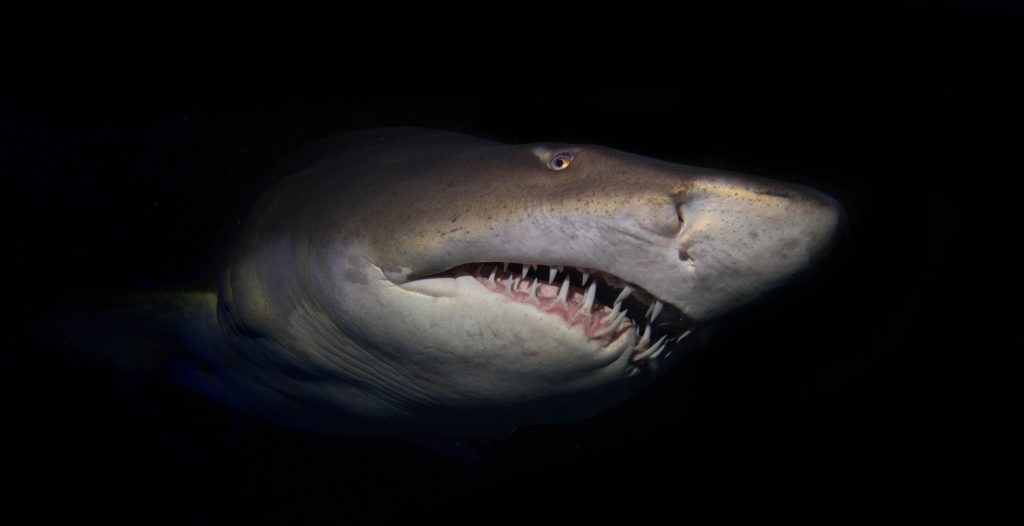
Comparing the size of sharks from great whites to whale sharks, there’s no denying that some sharks are true behemoths of the sea. But how do sharks measure up against us humans? And are they really as imposingly large as you might think?
To find out, we’re taking a look at 10 different species of sharks. How they size up against both us and each other.
Whale Shark
Redefining the term ‘gentle giant’, the majestic whale shark is the largest fish in our seas. Comparing the size of sharks to humans, they’re 10 times the length. Nevertheless, these huge filter feeders are entirely harmless. Their gentle nature means they’re one of the most popular sharks to dive with. Remarkably, some of the largest whale sharks weigh in at 30 tonnes – four times heavier than an African bull elephant.
Basking Shark
Basking sharks have one of the most impressive mouths of the deep. Their jaws are able to open over a metre wide. Happily, like their slightly larger cousins, they’re filter feeders and pose little risk to humans. This is a good job, as comparing the size of sharks to humans, they’d almost certainly be able to swallow a person whole. Basking sharks travel vast distances on their annual migration and have been sighted in UK waters.
Megamouth Shark
As its name suggests, the megamouth shark is known for its huge mouth. Like basking and whale sharks, it uses for swallowing up masses of plankton in one tremendous gulp. Despite its cool name and large size, little is known about the megamouth, and it wasn’t discovered until 1976. Believed to be migratory, most sightings of the megamouth have occurred in the Pacific Ocean. This is where it’s known to feed on plankton and jellyfish.
Greenland Shark
Like the megamouth, little is known about the Greenland shark. Save for the fact that they live a very, very long time. This is thought to be due to the cold waters in which they live slowing their metabolism. This means they reach maturity much later than other sharks. The largest Greenland shark ever recorded was 7.3 metres. However, biologists agree that there may be much bigger individuals in the deep.
Great White Shark
With size, strength and over 300 razor-sharp teeth; great white sharks are truly formidable predators. On average, adult great whites measure in at around 4.5 metres, though many grow much bigger, up to 6 metres. But while they may be one of the ocean’s top apex predators, great whites are not innately aggressive to humans. They attack out of curiosity rather than the want of a meal. Instead, they prefer to feed on fattier prey, like seals, sea lions and even small whales.
Great Hammerhead Shark
The otherworldly great hammerhead is one of the most unique species of shark, for obvious reasons. Native to tropical waters, these unusual creatures feed along the seabed. They use their excellent vision and electrical signals to hunt their preferred meal, stingrays. Sadly, their long fins make them a lucrative target for the shark fin trade. This has led to them now being classified as critically endangered.
Bluntnose Sixgill Shark
The bluntnose sixgill shark is the largest species of fossil shark. A family of primordial marine creatures which have been around since the Jurassic period. These deep-water predators are identified by their flat heads, yellow teeth, long tail and their unique row of six-gill flaps. Despite its size, the Sixgill isn’t an apex predator. It is vulnerable to a handful of other animals, including killer whales, great white sharks and the Steller sea lion.
Common Thresher Shark
Often sighted in UK waters; the common thresher shark is a member of the thresher family, a genus of shark recognised for their long tailfins. Found throughout the world’s oceans, except for the polar regions. The Common Thresher is the largest, with its tail alone being longer than the average human. The thresher’s greatest strength is its speed. Its massive tailfin helps it glide through the water at an eye-popping pace.
Sand Tiger Shark
Native to the subtropical and temperate waters of the continental shelf. The Sand Tiger Shark is a relatively placid, slow-swimming shark. Sand Tigers are regularly sighted in the waters of Japan, South Africa as well as some parts of the Mediterranean. Visitors to Blue Planet Aquarium can get up close to this wonderful species in our Underwater Shark Tunnel exhibit.
Dwarf Lanternfish
Demonstrating the remarkable biodiversity of sharks, we have the Dwarf Lanternfish, the smallest shark species in the world. Native only to the continental slopes of Colombia and Venezuela. This little-known creature is a type of dogfish shark, which grows to a maximum of 20 cm. In comparison to Whale Sharks, it’s hard to believe that these remarkable animals are part of the same group.
At Blue Planet Aquarium, we believe that sharks of all shapes and sizes are incredibly fascinating. From the smallest species to the biggest predators.
We hope you’ve enjoyed this in-depth look at different shark species and how they measure up against us humans. For close encounters with sharks and other creatures of the deep, join us for an educational visit to Blue Planet Aquarium. Find ticket and visitor information on our homepage.
